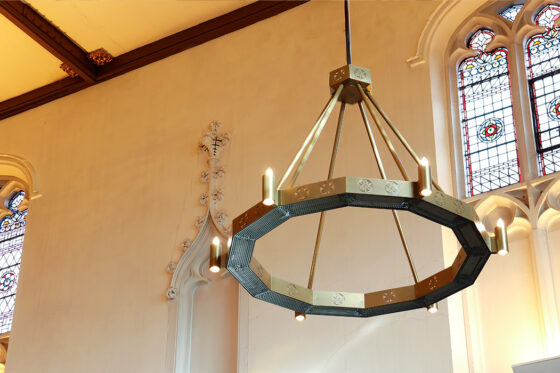Radiant heating#
Radiant or “infrared” heating mostly heats the people by making the surfaces that surround them warmer. It only has to be run while people are in the space, or in very cold spaces, with a short pre-heat to warm the furnishings and building surfaces before people enter. If you run it for long enough, it will warm the air as well as a side effect of warming the surfaces.
There are venues in frequent use that have radiant heating as their only heating, but we think its real strength is for venues that for some reason will remain in low occupancy.
Radiant heating might not look like you expect. It doesn’t all glow. Most panels are mounted high up for safety and to give them wide angle coverage of the space that keeps the warmth from being blocked by furniture. You are most likely to spot radiant heating in hospitals, where it is popular because it doesn’t circulate dust. In modern, smaller spaces, flat white ceiling panels are the most common form. They can be hard to spot. Radiant heating can also come as chandeliers or integrated with the lighting.

Picture source: Wikimedia Commons, Copyright Palytsialvan, CC-BY-A-SA-4.0, our crop

Picture by permission of the manufacturer, Herschel
Your choice isn’t all or nothing. For instance, if you want to switch to an air source heat pump but it won’t cover all your heating needs, you might use the pump to provide a constant level of background heating, and just add infrared in the depths of winter or for groups that need more heating than usual. Similarly, if you have a condensing boiler that will do service for a while yet, you could use radiant heating to allow you to run the boiler on low instead of high, perhaps providing a setback temperature, and get better energy efficiency from your gas that way, switching to a heat pump when the boiler breaks. You could also use radiant heating as an alternative form of heating in rooms that need warmth when the rest of the space is empty.
Radiant heating has some obvious advantages over gas boilers and heat pumps - they only need maintenance if something breaks, there’s no noise and no need to site anything outside the building, and any pre-heat period might be short enough that you can leave users to control it, getting rid of the task of programming the heating week by week. The running cost depends on how much you use it but is easy to predict.
You’ll need professional help to assess what type is best for your application and calculate heating requirements for the space so you don’t install more heating than you need - users aren’t good at turning things off or down.
Radiant panels may be news to many of us, but they aren’t a new technology at all – they’ve been used in the more sensitive parts of hospitals for years because they don’t collect and redistribute dust like radiators do. In hospitals they are often mounted on the ceiling to keep them away from people and free up the wall space. That means there are also radiant panel manufacturers who have been around for years and they are much more likely to provide good equipment than the many Chinese factories now starting to make and sell them. Many of the long-standing British manufacturers will design a system for you using their equipment. We wouldn’t recommend asking an installer to do a design, but you can trust the manufacturers to get this right and if an independent consultant is really more used to gas boilers, this is the approach they’ll use themselves.
Get the right design
Like with heat pumps, radiant heating has to be designed for your space or you will be disappointed with the results. Many of the early adopters bought and installed their own equipment and didn’t choose the right wavelength, power, and beam angles for their spaces, partly because so few independent heating consultants are willing to take on radiant heating design. We’ve taken advice from an independent heating consultant to help groups know how to avoid this problem. We were surprised when he told us to go straight to the manufacturers.
A reputable manufacturers will design a aystem using their products to suit your space. You can trust them to get it right. They will make sure you get the right wavelength for the size of your space. They will also determine the right angles and locations for heaters to give even coverage throughout the space. Frenger, Solray, and Consort Claudgen are all reputable manufacturers, but there are probably others. The Consort Claudgen “Twinzone” is unusual in being able to deliver narrow beam or wide beam heating, depending on how it is assembled. Any decent manufacturer will give you full technical specifications for what they sell. They will often have case studies showing installations similar to what they intend for your space. If, like many of the no-brand options, they don’t, you’ll want to steer well clear.
The manufacturers won’t install the panels for you. With gas boilers and heat pumps, the installer’s skills make a real difference to performance, efficiency, and longevity. With radiant panels, they don’t. Any competent electrical contractor should be able to install the equipment to a specified design but the manufacturers sometimes also have installers they recommend.
Make sure you think about how power will be supplied to the panels. You might not have enough power available in the right places to run them, but changing this can be very expensive, especially if you need a completely new supply to the building. Some models of panel require a three phase supply and you might not have one.
In heritage buildings, you’ll want to think about how the panels can be mounted without damaging the building and to be careful about the potential effects of the heating on any delicate objects in the space like paintings and musical instruments.
